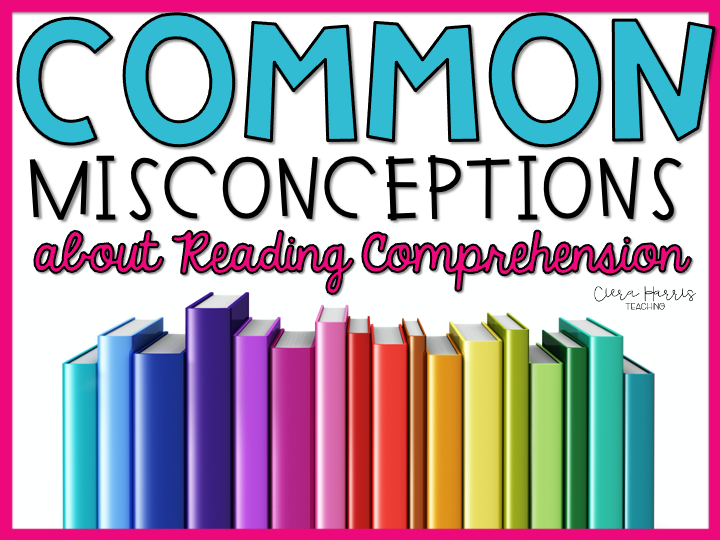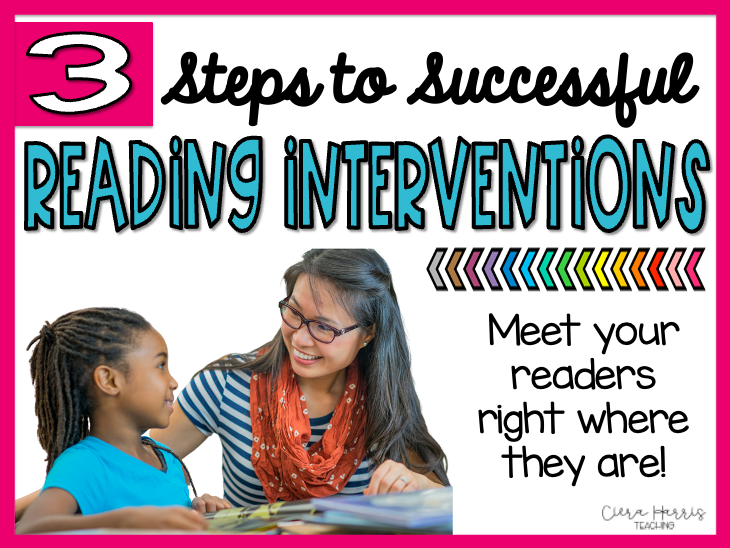Teaching reading means that reading teachers need to be on the up-and-up about the newest research, trends, and strategies that work for our students. But who has the time to be that on top of it? ? I know I don’t! So instead, I have gathered the 4 common misconceptions about reading comprehension in hopes to help!

Want to watch the video instead? Check it out below! Make sure to subscribe to get updates on all new content!
(This post contains Amazon affiliate links. This means that Amazon sends me a little pocket change, at no cost to you, if you purchase through one of these links. This helps keep my site running and funds giveaways for you!)
Common Misconception #1: Answering questions is enough to gauge comprehension
Did you know that ‘retelling’ is actually the bottom-most level of comprehension understanding? It’s true. Just because a reader and repeat the basic pieces of a text doesn’t mean they can comprehend it. This information is superficial (in most cases). The true purpose of that text hasn’t been and cannot be uncovered simply by repeating the story elements and basic events. This is why programs, such as Accelerated Reader, cannot accurately depict a child’s reading ability.
It’s okay to ask these questions in moderation but always followed by or connected to a more rigorous and deep question that will help expose the meaning of the text. When a student truly comprehends a text, they should be able to apply reading strategies to the text and participate in conversations about the text. They should be able to express connections made while reading and draw their own conclusions about the story. Comprehension is always the goal when reading.
Focus your time on strategies that will build students’ deep understanding of texts such as activating prior knowledge, building their schema, and utilizing their metacognition. The basic Q&A’s have got to go!
Common Misconception #2: Reading skills make readers more successful
 I alluded to this common misconception about reading comprehension in the previous section, but it’s so important it needs its own number! Reading skills are different than reading strategies. There’s an actual reason why they are different and I have it all outlined in the linked post in the previous sentence. If you’re unsure of that difference, make sure to head over and take a quick read! The main difference in the two is that reading strategies INVOLVE the reader.
I alluded to this common misconception about reading comprehension in the previous section, but it’s so important it needs its own number! Reading skills are different than reading strategies. There’s an actual reason why they are different and I have it all outlined in the linked post in the previous sentence. If you’re unsure of that difference, make sure to head over and take a quick read! The main difference in the two is that reading strategies INVOLVE the reader.
Skills such as main idea, sequencing, cause/effect, etc are all focused on the text. They are about the text and only the text. Readers can technically ‘understand’ these skills without actually having true comprehension. On the other side, strategies such as visualizing, synthesizing, schema, and metacognition all involve the reader. They cannot be done without the reader’s thoughts and input. If we want our students to be actively involved in the text, putting in their own schema and ideas, pulling apart the text to determine where connections can be made and how they fit into it, then the focus needs to be on strategies.
Research shows that it’s the strategies that make the difference in students’ abilities to comprehend than skills. When readers struggle, many teachers think that it is skills they need support in or help with, but in most cases – struggling readers need to have the reinforcement of strategies. Strategies will then support the students’ understanding of the skills.
Common Misconception #3: Lower readers have lower cognitive abilities than normal readers
When we have readers there is always a variety of levels that the readers are currently working at. With our lower readers, it’s not that their cognitive abilities are lower (in most cases). It’s that the connections they have built when reading are different in their brain. Since literacy starts at such a young age, many times lower readers have different exposures and experiences early on that changed the course of their understanding of literacy. Basically, teachers need to take steps backwards to see where the underlying holes are and proceed from there to rebuild.
Another factor to consider is the knowledge gap, sometimes referred to as the achievement gap. From school to school and student to student, there is sometimes a large discrepancy in achievement. Many educators think this is due to a difference in abilities but in fact, it’s due to a difference in knowledge. Students who come from lower economic homes tend to have fewer or different life experiences than students in average or upper economic homes.
This difference in life experiences becomes known as the knowledge gap. This gap is what, unfortunately, truly causes the difference in achievement from school district to school district. Schema is everything when it comes to reading and comprehension. Without schema, which comes from life experiences, students can struggle immensely when reading. This knowledge gap is wildly discussed in the popular book, The Knowledge Gap.
Common Misconception #4: Teachers have to differentiate to meet the needs of all students
This is a big common misconception about reading comprehension and one I might get the most push back on. Differentiation doesn’t HAVE to happen in order for support for all students to take place. Actually, too much differentiation can  actually slow down progress for many students. How does this happen?
actually slow down progress for many students. How does this happen?
When teachers differentiate for their students, they are doing what they think is best for their students. They are looking at the current needs of each group of students and applying strategies or providing content for that particular group. But the problem is when we are constantly giving specific content to specific groups of students, we are inevitably causing the gap between the ‘lower’ students and the ‘average/advance’ students to become much bigger. The other students continue to move on while the lower students continue to miss out on grade-level appropriate standards. So essentially by differentiating, we are actually prolonging the gap that we are trying to close.
Now, this doesn’t mean there isn’t a time and place for small group instruction, interventions, etc. This simply means that teachers need to be very intentional about exposing ALL students to grade-level content and then supporting where needed. When teaching grade-level content, there are ways to ensure all students learn without having to differentiate or change the overall objective for students who are struggling. This lies in the scaffolding that takes place in the lesson.
Maybe you use an excerpt from the text instead of the entire text? Or you use a simplified version of the graphic organizer? Maybe you support the lower students by giving them a quick mini-lesson after the main lesson to ensure they have understood the concept. There are lots of ways to make sure all students get the exposure to grade-level content they need to continue to grow and learn.
What do you think about these common misconceptions about reading comprehension? Do you agree with them? Would you add any to the list? I’d love to know! If you want to save this post for later, make sure to pin the image below!






